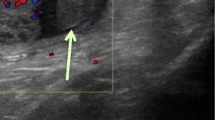Abstract
In this pictorial essay the authors review the normal sonographic gray-scale and Doppler appearance of the pediatric scrotum with an emphasis on technique. The authors present an update on ultrasound diagnosis and outcomes in testicular torsion and differentiation from other acute scrotal processes, as well as sonographic imaging of testicular microlithiasis and uncommon or atypical scrotal masses including splenogonadal fusion, polyorchidism, meconium peritonitis and epidermoid cyst. Further, the authors discuss testicular neoplasms in the context of testicular microlithiasis.













Similar content being viewed by others
References
Delaney LR, Karmazyn B (2013) Ultrasound of the pediatric scrotum. Semin Ultrasound CT MR 34:248–256
Karmazyn B (2010) Scrotal ultrasound. Ultrasound Clin 5:61–74
Sung EK, Setty BN, Castro-Aragon I (2012) Sonography of the pediatric scrotum: emphasis on the Ts — torsion, trauma, and tumors. AJR Am J Roentgenol 198:996–1003
Aso C, Enriquez G, Fite M et al (2005) Gray-scale and color Doppler sonography of scrotal disorders in children: an update. Radiographics 25:1197–1214
Carkaci S, Ozkan E, Lane D, Yang WT (2010) Scrotal sonography revisited. J Clin Ultrasound 38:21–37
Cokkinos DD, Antypa E, Tserotas P et al (2011) Emergency ultrasound of the scrotum: a review of the commonest pathologic conditions. Curr Probl Diagn Radiol 40:1–14
Yang C Jr, Song B, Liu X et al (2011) Acute scrotum in children: an 18-year retrospective study. Pediatr Emerg Care 27:270–274
Kalfa N, Veyrac C, Lopez M et al (2007) Multicenter assessment of ultrasound of the spermatic cord in children with acute scrotum. J Urol 177:297–301
Cattolica EV, Karol JB, Rankin KN et al (1982) High testicular salvage rate in torsion of the spermatic cord. J Urol 128:66–68
Liang T, Metcalfe P, Sevcik W et al (2013) Retrospective review of diagnosis and treatment in children presenting to the pediatric department with acute scrotum. AJR Am J Roentgenol 200:444–449
Beni-Israel T, Goldman M, Bar Chaim S et al (2010) Clinical predictors for testicular torsion as seen in the pediatric ED. Am J Emerg Med 28:786–789
Srinivasan A, Cinman N, Feber KM et al (2011) History and physical examination findings predictive of testicular torsion: an attempt to promote clinical diagnosis by house staff. J Pediatr Urol 7:470–474
Altinkilic B, Pilatz A, Weidner W (2013) Detection of normal intratesticular perfusion using color coded duplex sonography obviates need for scrotal exploration in patients with suspected testicular torsion. J Urol 189:1853–1858
Baker LA, Sigman D, Mathews RI et al (2000) An analysis of clinical outcomes using color doppler testicular ultrasound for testicular torsion. Pediatrics 105:604–607
Galina P, Dermentzoglou V, Baltogiannis N et al (2015) Sonographic appearances of the epididymis in boys with acute testicular torsion but preserved testicular blood flow on color Doppler. Pediatr Radiol 45:1661–1671
Driver CP, Losty PD (1998) Neonatal testicular torsion. Br J Urol 82:855–858
Snyder HM, Diamond DA (2010) In utero/neonatal torsion: observation versus prompt exploration. J Urol 183:1675–1677
Roth CC, Mingin GC, Ortenberg J (2011) Salvage of bilateral asynchronous perinatal testicular torsion. J Urol 185:2464–2468
Baglaj M, Carachi R (2007) Neonatal bilateral testicular torsion: a plea for emergency exploration. J Urol 177:2296–2299
Yerkes EB, Robertson FM, Gitlin J et al (2005) Management of perinatal torsion: today, tomorrow or never? J Urol 174:1579–1582
Djahangirian O, Ouimet A, Saint-Vil D (2010) Timing and surgical management of neonatal testicular torsions. J Pediatr Surg 45:1012–1015
Tiwary CM (1989) Testicular injury in breech delivery: possible implications. Urology 34:210–212
Ben-Sira L, Laor T (2000) Severe scrotal pain in boys with Henoch-Schönlein purpura: incidence and sonography. Pediatr Radiol 30:125–128
Middleton WD, Teefey SA, Santillan CS (2002) Testicular microlithiasis: prospective analysis of prevalence and associated tumor. Radiology 224:425–428
Backus ML, Mack LA, Middleton WD et al (1994) Testicular microlithiasis: imaging appearances and pathologic correlation. Radiology 192:781–785
Cast JE, Nelson WM, Early AS et al (2000) Testicular microlithiasis: prevalence and tumor risk in a population referred for scrotal sonography. AJR Am J Roentgenol 175:1703–1706
Trout AC, Chow J, McNamara E, Darge K (2016) Large multi-center study and the association between testicular microlithiasis and testicular neoplasia in a pediatric population. Presented at the international pediatric radiology meeting Chicago, IL. Pediatr Radiol 46:S107–S108
Basbug M, Akgun H, Ozun MT et al (2009) Prenatal sonographic findings in a fetus with splenogonadal fusion limb defect syndrome. J Clin Ultrasound 37:298–301
Varma DR, Sirineni GR, Rao MV et al (2007) Sonographic and CT features of splenogonadal fusion. Pediatr Radiol 37:916–919
Stewart VR, Sellars ME, Somers S et al (2004) Splenogonadal fusion: B-mode and color Doppler sonographic appearances. J Ultrasound Med 23:1087–1090
Danrad R, Ashker L, Smith W (2004) Polyorchidism: imaging may denote reproductive potential of accessory testicle. Pediatr Radiol 34:492–494
Amodio JB, Maybody M, Slowotsky C et al (2004) Polyorchidism: report of 3 cases and review of the literature. J Ultrasound Med 23:951–957
Arellano CM, Kozakewich HP, Diamond D, Chow JS (2011) Testicular epidermoid cysts in children: sonographic characteristics with pathological correlation. Pediatr Radiol 41:683–689
Author information
Authors and Affiliations
Corresponding author
Ethics declarations
Conflicts of interest
The authors have no financial interests, investigational or off-label uses to disclose.
Rights and permissions
About this article
Cite this article
Alkhori, N.A., Barth, R.A. Pediatric scrotal ultrasound: review and update. Pediatr Radiol 47, 1125–1133 (2017). https://doi.org/10.1007/s00247-017-3923-9
Received:
Accepted:
Published:
Issue Date:
DOI: https://doi.org/10.1007/s00247-017-3923-9




